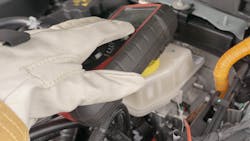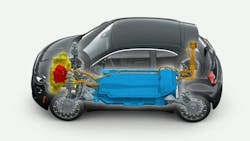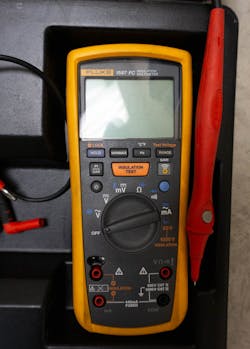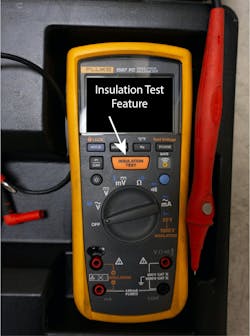Those pesky orange cables have been causing body technicians concern since the release of high-voltage systems on hybrid and electric vehicles. While everyone was concerned about the risk from these high voltage systems, all the focus seemed to be on properly ensuring the high-voltage batteries were disconnected properly before service.
But what about after the repair? What can be done to confirm that all the systems are safe before reinstalling the high voltage battery?
If you have not heard of isolation testing, it is an important component of high voltage system safety. Let’s jump in and take a look at how you can work more safely during your next hybrid or electric vehicle repair.
What is loss of insulation (Isolation)?
Loss of insulation, or loss of isolation, is a term you may hear being thrown around interchangeably. While the description may be straightforward and self-explanatory, it is not always so simple to understand.
Normal 12-volt systems found on modern automobiles have what is normally described as a chassis ground. These are the systems that you are used to seeing in your bays every day. Using the chassis and other conductive components of the vehicle, the ground system simply travels through the chassis of the vehicle to find ground. This system has been used for many years due to the simplicity and to also reduce the amount of wiring to complete a circuit. Just imagine if the already large wire harnesses in the vehicle still needed to travel back to the battery to complete the circuit.
While this form of ground is relatively safe for a 12-volt system, a high-voltage battery system would be dangerous if it used the same type of chassis ground.
To prevent the risk and danger of electrical shock, electric and hybrid vehicles use a floating ground. Instead of the ground circuit being bonded to the chassis, the power (+) and ground (-) cables are attached only to high-voltage components and cables, essentially isolating them from the chassis.
When vehicles are new, wire insulation and high voltage components function properly under the high-voltage and high-current needs of the systems. Over time, however, these components can begin to fail. High-voltage cables begin to lose insulation abilities, or high-voltage components can develop internal leaks or shorts. While the chances of this occurring during normal conditions is small, other events such as a collision, system failure, or even a flood could increase the potential for isolation loss. This causes concern for technicians and can also cause the vehicle to set Loss of Isolation codes to warn you of the danger that is present.
Most vehicle manufacturers will have a data parameter ID (PID) that indicates the isolation value. Depending on the vehicle, it may even be possible to command an onboard isolation test and compare the readings to service information values. Some of the more common Loss of Isolation codes you might see during this pre-scan are:
P0AA6: Hybrid Battery Voltage System Isolation Fault
P1AF0: Drive Motor 1 Control Module Hybrid/EV Battery Voltage System Isolation Lost
Important step of any vehicle repair
While the insulation breakdown of a wire can cause a loss of isolation, this can also be caused by a cable that is damaged during a collision. Or, harder to detect would be a partially damaged cable that was not noticed during the repair.
Before any body repairs begin, technicians need to identify faults or any issues that the HV system may have. As Bud Center, director of technical products and curriculum at I-CAR says, “You should never assume everything is okay when approaching a collision-damaged EV vehicle.” Doing a pre-scan is important as part of this check. Any technicians who are working on the vehicle should use the correct process and procedures for that specific vehicle. Many vehicle manufacturers will have specific tools and training required before working on their vehicles.
Proper technician training before working on the vehicle and a pre-scan is very important in this situation. If a post-repair scan is being completed, this means the vehicle's battery is already back in the vehicle. If any high voltage cable or components are moved during repair — even partially moved to make room to remove a different component — make sure you complete a loss of isolation test before powering up the high voltage battery.
“Doing an isolation check, in accordance with vehicle maker service procedures, will help ensure that when everything is reinitialized, the vehicle will be safe,” Center says.
As mentioned, a partially damaged wire that was not contacting the chassis before a repair could possibly make contact after moving components around to complete a repair. A high-voltage cable or connector that has been compromised can cause moisture intrusion which can later result in a loss of isolation. Both of these situations present a dangerous condition if the high voltage battery is powered up before verifying isolation.
Testing a high voltage electrical system for the loss of isolation should be completed only by a trained professional. The following are simple guidelines and an overview to help you understand what loss of isolation testing is.
Proper tools
Having the proper tools and technician certification to test high-voltage systems is crucial. Properly fitted and tested Class 0 high voltage gloves are vital and needed before attempting to service a high voltage system.
A loss of isolation test is completed using what is called a megohmmeter. Yes, megohms, as in one million ohms. While most normal multimeters will use 3-4 volts for testing resistance in a circuit, a megohmmeter has the ability to apply up to 1,000 volts to the system to check resistance.
Sending such a large electric voltage through the system tests the insulation capabilities of the high-voltage components. A large megohm reading is considered normal, but always refer to service information for the correct information.
The most common meters you will find are the Fluke 1507 or 1587. These meters have the ability to apply up to 1,000 volts, allowing them to be used for testing on most automotive manufacturers’ vehicles. Because these meters can send out 1,000 volts, it is critical to take the correct precautions when using these meters when testing to avoid personal injury and damage to the vehicles’ systems.
Consult service information
Before completing any electrical system on the vehicle, make sure you review service information for the proper test procedure. Test point areas, actual test voltage applied, and safety warnings will vary from vehicle to vehicle, so make sure you check before you test.
Testing loss of isolation
Loss of isolation testing is generally completed after the high voltage battery is removed from the system. Always follow manufacturers’ guidelines to ensure proper testing procedures are used. Here is a common test procedure used to test loss of isolation of a transmission assembly containing a three-phase electric motor:
- Set the vehicle to a safe condition according to service information.
- Test the megohmeter to ensure proper functionality: As you would with a regular multimeter, it is vital to complete a lead inspection and fuse test before you begin use. However, when completing an insulation test, your multimeter manufacturer may suggest completing another test before starting. An internal meter battery test is important, as an insulation test will apply anywhere from 250 - 100 volts during testing. So, it is vital the battery has enough capacity before testing. Consult your meter's instructions for specifics. For the Fluke 1587, when you first use the meter, you turn the knob to the setting labeled Insulation. Once this is done, a load check is completed and it will display a failure icon if the battery fails. You can, however, also complete a separate test on the batteries. To complete the battery test on this meter, you simply press on the hold button and turn the dial to Insulation setting. This gives the charge level of the battery.
- Don high-voltage gloves.
- Place the ground lead of the meter to the case of the transmission.
- Set the meter to the correct insulation test voltage setting as per service information.
- Place the “red” lead onto terminal “A” of the transmission connector.
- Push and hold the Insulation Test button until the megohm reading is obtained.
- Complete test for “B” and “C” terminals of the transmission connector
- Compare readings to service information
Once you have the readings, you can compare these to the values outlined by service information. With this information, you can repair the issue that is present or power up the high-voltage battery with confidence knowing the repair has been completed properly.
While there are many different causes of a loss of isolation, there is one common problem that technicians run into that you should be aware of. There is even a chance you may have run into this issue before.
Take care in working with air conditioning
Front-end repairs and condenser replacement could be considered one of the more common repairs seen in a general repair or body shop. While electric and hybrid vehicles operate using the same air conditioning principles, they use slightly different components such as the high-voltage compressor.
While it operates just like a normal A/C compressor, changing a low-pressure vapor refrigerant to a high-pressure refrigerant — it requires a special oil to function correctly.
While most air conditioning systems use polyalkylene glycol (PAG) oil, hybrid and electric vehicle compressors require Polyolester (POE) oil. POE oil is designed with special dielectric properties to be used in high-voltage compressor applications. Simply put, POE oil does not conduct electricity as easily as does PAG oil. The concerns of using the wrong oil in an air conditioning system are real and can not only cause damage to the system but can also cause bodily harm.
If a recovery/recharge machine that has PAG oil is used, over time the PAG oil in the machine can contaminate the electric vehicle’s air conditioning system. This buildup of PAG oil will allow electrical current to flow through the system, possibly allowing the high-voltage motor inside the compressor to conduct electricity to the compressor case.
This problem generally shows up in the shop bay as a loss of isolation code set in a module. If the air conditioning system has caused this code to set, most likely an entire air conditioning system replacement is needed to be able to properly clean the system of the incorrect oil used. This is a repair bill no shop wants to see.
Shops that repair a high volume of electric or hybrid vehicles should look into investing in a designated machine that uses only POE oil. While it’s expensive to purchase a new machine, it is one of the best ways to prevent this from happening.
Work safely at all times
Working on high-voltage vehicle systems can be overwhelming for technicians. Always make sure that technicians are properly trained and meet any required certifications before asking them to work on these vehicles. Safety is the priority for any technician when working on electric vehicles. Make sure they have the required safety equipment, tools, and service information that is required before making a repair.
Always work safely.








